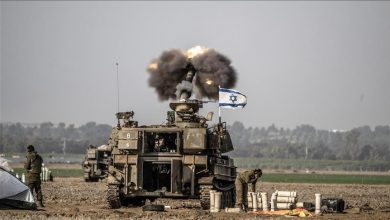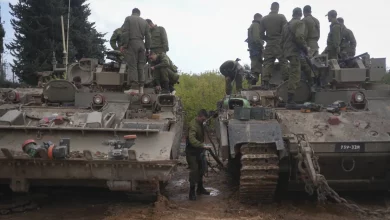İsrail’in, ABD’nin İran’la yapacağı nükleer müzakereleri kabullenip kabullenmeyeceği merak konusu

Israel Hayom gazetesi analistlerinden Amnon Lord, ‘ Gantz’ın İsrail’in yeni bir nükleer anlaşmayla bir arada var olabileceği yönündeki açıklaması, hükümetin İran’daki nükleer konusunda bağımsız bir politikadan vazgeçtiğini gösteriyor.’ dedi.
İsrail’de siyasi çevreler ABD’nin İran ile nükleer müzakerelere dönmesine karşı çıkıyor ancak mevcut hükümet selefinin aksine tutumunu fazla gürültü çıkarmadan ifade etmeyi tercih ediyor.
İsrail askeri çevreleri ise İran’ın nükleer ve füze projelerinin yanı sıra bölgedeki faaliyetlerini durdurmayı garanti ettiği sürece siyasi çözümde yanlış bir şey görmüyor.
İsrailli gözlemciler, mevcut hükümet ile ABD yönetiminin birbirlerine duydukları ihtiyacın, iki tarafı da çatışma yerine anlaşmayı tercih etmeye yönelttiğini belirtiyor.
Bu, İsrail Başbakanı Naftali Bennett ile ABD Başkanı Joe Biden arasında ağustos ayında Beyaz Saray’da yapılan ilk görüşmeye de yansıdı.
Bennett, ABD’nin İran’la anlaşmaya dönmesini kabul ettikleri yönünde herhangi bir işaretten kaçınırken İsrail Savunma Bakanı Benny Gantz, İsrail’in yeni bir anlaşmayı bazı şartlarla kabul edebileceğini ifade etti.
Foreign Policy dergisine verdiği röportajda, nükleer anlaşmaya geri dönülmesi için yapılan müzakerelere ilişkin Gantz, “ABD şu an İran nükleer programını bir kutuya geri koyma yaklaşımında. Bunu kabul ederim.” ifadesini kullanmıştı.
Müzakerelerin başarısız olması halinde İsrail’in İran üzerinde geniş ekonomik baskıyı içeren, ABD liderliğinde uygulanabilir bir B planı görmek isteyeceğini dile getiren Gantz, İsrail’in askeri harekatının da seçenekler arasında olduğuna işaret etmişti.
İsrail Başbakanı Naftali Bennett, Gantz’ın bu açıklamaları hakkında yorum yapmazken, İsrail sağı Gantz’ın açıklamalarını İran’a bir teslimiyet olarak değerlendirdi.
Eski Başbakan Binyamin Netanyahu’ya yakınlığıyla bilinen Israel Hayom gazetesi analistlerinden Amnon Lord, “Gantz’ın İsrail’in yeni bir nükleer anlaşmayla bir arada var olabileceği yönündeki açıklaması, hükümetin İran’daki nükleer konusunda bağımsız bir politikadan vazgeçtiğini gösteriyor.” dedi.
Lord, “Bunlar, özellikle İran’la nükleer tesislerinin uluslararası gözlemcileri hakkında yapılan görüşmeler gölgesinde sefil açıklamalar. Genel olarak, İranlılar nükleer tesislerinde kamera yerleştirilmesini kabul ettiler ancak kaydedilenlerin izlenmesi için monitörlere hafıza kartı vermeyecek.” ifadelerini kullandı.
“Gantz İsrail ordusunun tutumunu yansıtıyor”
İsrail’in Kanal 12 televizyonu analistlerinden Muhammed Mucadele, Gantz’ın yaptığı açıklamayla İsrail ordusunun tutumunu dile getirdiğini kaydetti.
İsrail’deki askeri ve siyasi çevreler, İran ile P5+1 olarak da bilinen BM Güvenlik Konseyi Daimi Üyeleri olan ABD, Çin, Rusya, Fransa, İngiltere ve Almanya arasında anlaşma olmasını desteklediklerini ve halen destekliyor olduklarını vurgulayan Mucadele, “İsrail için iyi bir anlaşma yapılması demek, anlaşmanın savaş başlıkları ve balistik füzelerin geliştirilmesi ile uranyum zenginleştirilmesinin önlenmesini içermesi demektir. İsrail tarafı böyle bir anlaşmanın İran’ın nükleer bombaya ulaşmasını engelleyeceğini düşünüyor.” diye konuştu.
Gantz’ın açıklamalarının askeri kesimin tutumunu yansıttığına işaret eden Mucadele, siyasi kesimin aleni şekilde bunları dile getiremeyeceğini zira böyle bir durumda İran ile uluslararası bir anlaşmayı İsrail’e zarar verecek stratejik bir hata olarak gören Netanyahu ile sağ kesim tarafından eleştirileceklerini belirtti.
Netanyahu, gelecekte potansiyel müttefik olarak gördüğü için Gantz’a yönelik sert eleştirilerden kaçındığını söyleyen Mucadele, “Gantz’ın bu tür açıklamalar yapması daha kolay çünkü gelecekte hükümet kurması durumunda Netanyahu’nun kendisine ihtiyacı olduğunu ve eleştiride ileriye gitmeyeceğini biliyor.” diye konuştu.
Mucadele, ayrıca Gantz’ın Savunma Bakanı olduğu için açıklamalarının siyasetten çok askeri düzeyde olduğuna dikkati çekerek şunları kaydetti:
“Gantz’ın açıklamalarının siyasi düzeyde bir temsiliyetinin olduğunu düşünmüyorum. Hükümet içerisinde de bu konuda anlaşmazlıklar var. İran ile bir anlaşmayı destekleyen cenah, Dışişleri Bakanı Yair Lapid, Savunma Bakanı Gantz, Sağlık Bakanı Nitzan Horowitz ve Ulaştırma Bakanı Merav Michaeli’den oluşuyor.”
Ayrıca İran’la herhangi bir anlaşmayı reddeden aralarında Başbakan Bennett, Adalet Bakanı Gideon Sa’ar ve Maliye Bakanı Avigdor Lieberman’ın da bulunduğu başka bir cenahın da olduğunu vurgulayan Mucadele, “Bennett ve Biden arasında, İran ile anlaşma konusundaki İsrail’in tutumunu medyada değil, kapalı odalar arkasında ifade edeceği bir anlaşma bulunuyor. Bu, 2015’te İran anlaşmasına karşı küresel ve yerel bir kampanya başlatan Netanyahu’nun yaptığını mevcut hükümetin yapmayacağı anlamına geliyor.” diye konuştu.
Mucadele, şöyle devam etti:
“ABD, İsrail’e nükleer anlaşma konusundaki tutumlarını dikkatle dinleyeceğine söz verdi ancak kapalı kapılar ardında. Biden, Bennett’e İran ile anlaşma istediğini açıkça belirtti. Mesele bir anlaşma olup olmayacağı değil, bu anlaşmanın nasıl yapılacağı, şartlarının ne olacağı ve İran’ı sadece nükleer konusunda değil, aynı zamanda balistik füzeler ve İran’ın Ortadoğu’daki faaliyetleri konusunda da ne kadar kısıtlayacağıdır.”
“İran’a karşı bağımsız bir askeri seçenek şu anda masada değil”
Haaretz gazetesinin askeri analistlerinden Amos Harel gazetede yayımlanan makalelerinden birinde, “Amerikan politikası sinir bozucu ancak İsrail tarafı yavaş yavaş bunu kabul ediyor.” ifadesini kullandı.
İsrail’in çekincelerinin Başbakan Bennett’in ABD Başkanı Biden ile geçen ay Washington’da yaptığı görüşmede ve toplantılarda dile getirildiğine işaret eden Harel, şunları kaydetti:
“Görüşmelerin bir bölümünde İsrailliler, Amerikalılara, nükleer projesini ilerletmeye devam etmesi halinde dillerini sertleştirmelerini ve İran’a karşı gerçek bir askeri tehdit oluşturmalarını önerdi ancak ABD yönetimi, İsrail ile sıcak dostluklarına ve iyi ilişkilere rağmen bu konuda hevesli değildi.”
Harel, “Üst düzey İsrailli yetkililerin açıklamalarına rağmen İran’a karşı bağımsız bir askeri seçenek şu anda masada değil.” değerlendirmesinde bulundu.





